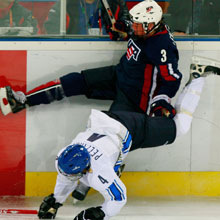 Team Canada celebrates their 4-1 victory over Sweden to win the gold medal in women's ice hockey during the 2006 Winter Olympic Games in Turin, Italy. (Brian Bahr/Getty Images)
Team Canada celebrates their 4-1 victory over Sweden to win the gold medal in women's ice hockey during the 2006 Winter Olympic Games in Turin, Italy. (Brian Bahr/Getty Images) "Oh my God, it's changed so much - sponsorships, uniforms, funding," says former hockey player Margot Page, commenting on the evolution of women's hockey since 1990. "I was (playing) in the era of the pink uniform."
Indeed, the notorious pink uniform, which was worn as a promotional ploy by Canada's women at the first women's hockey world championships 16 years ago, would be unthinkable today — a sign in and of itself that the sport has come a long way.
"Then, it didn't matter. We were playing - we were just happy to be on the international stage," says Page, who suited up for the national team from 1990 to 1994.
How things have changed
Women's hockey once had to fight for ice time, money, exposure and respect. That battle isn't over, but the sport's rising profile has meant increased corporate support and media attention for the national squads, both in Canada and the United States.
"Some of the players have people knocking at their door for sponsorships," says Page, now the head coach of the women's team Niagara University in western New York. "Whereas before when I wanted to play for the national team, I actually had to pay money (at a regional tryout.)"
At the grassroots level, more girls lacing up the skates has meant a bigger talent pool, which has really put pressure on the veterans of the Canadian and American teams. And as national programs such as Russia continue to improve as they become more serious about developing women's hockey, they should eventually start to put pressure on the U.S. and Canada to further increase the skill level and sophistication of their game.
"The speed, the physical side, the talent-level, the puck movement, the system stuff - before it was drop the puck and play your game. Now it's more technical." Says Page.
A wide-open, passing and stickhandling game
Because there is much less emphasis on size and brute strength than in the men's game, women's hockey is more wide-open, with the focus on the fundamentals of skating, passing and stickhandling.
"I think you see people wanting to try and execute and use their skill more, instead of individual tactics," says Page, who points out that international men's games are also more fluid than the NHL.
This will be less of an adjustment for the Canadian women than their male counterparts because the national team plays under international rules more and also because in the collegiate system, where most of the women's players develop, the rules are similar to the international game.
Page also says the games will go by faster than usual because international referees are much quicker to drop the puck on faceoffs.
Under international rules, once the referee blows the whistle, both teams have 15 seconds to get players into the faceoff circle and after that the puck is dropped whether players are in position to take it or not.







 Courtney Kennedy of the United States and Heidi Pelttari of Finland collide during the women's ice hockey bronze medal match during the 2006 Winter Olympic Games in Turin, Italy. (Brian Bahr/Getty Images)
Courtney Kennedy of the United States and Heidi Pelttari of Finland collide during the women's ice hockey bronze medal match during the 2006 Winter Olympic Games in Turin, Italy. (Brian Bahr/Getty Images)
